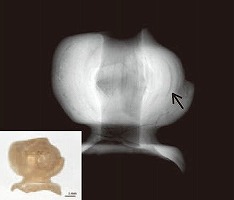
NABUNKEN NEWS vol.46
Investigation on the materials/structure of a multi-layered glass bead
We have carried out investigations on the materials/structure of a multi-layered glass bead unearthed from the Utsukushi 1st burial mound, located in Nagaokakyo City, Kyoto Prefecture. Upon investigation of the inner structure of the bead using X-ray radiography, it was found that the shape of the bead hole is curved inward at the center of the bead, and that an elongated air hole extends in the same direction as the hole direction along the curved surface of the bead. From here onwards, it can safely be concluded that this multi-layered glass bead was produced as a piece of a bead necklace by: (i) preparing two glass tubes with different diameters by drawing a soft glass; (ii) inserting a metal foil between the glass tubes, and heating them; and, (iii) forming concave portions by using a tool. Many multi-layered glass beads produced using a highly advanced technique such as this were found in the archaeological sites of the 1st - 3rd centuries in the areas surrounding the Black Sea.
Meanwhile, we applied a non-destructive measurement based on X-ray fluorescence spectroscopy to analyze the materials of the beads. Accordingly, we established that the metal foil was gold (Au), and that it was natron glass. Of all soda lime glasses, natron glass is the one which was probably created by selectively using evaporated salt (natural soda; aka, natron) output in Egypt, etc. as a fusing agent. It is well known that natron glass was broadly produced in the area, including in the Roman Empire. Through this material analysis, antimony (Sb), which was in widespread use for Roman glass as a decolorizer, was also detected.
As stated above, taking into consideration both the aspects of production techniques and chemical composition, this historic relic is highly likely to be a glass bead produced within the territory of the Roman Empire. It is hoped that future domestic and international advancement of classification research will facilitate the clarification of types and import channels of multi-layered glass beads distributed in ancient Japan.
(TAMURA Tomomi, Center for Archaeological Operations)
 An elongated air hole extending along the curved surface of the bead can be identified. |
